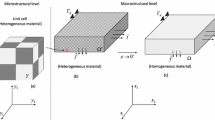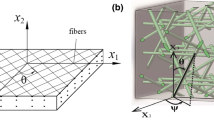Abstract
A higher-order structure for three-phase composites containing randomly located yet unidirectionally aligned circular fibers is proposed to predict effective transverse elastic moduli based on the probabilistic spatial distribution of circular fibers, the pairwise fiber interactions, and the ensemble-area homogenization method. Specifically, the two inhomogeneity phases feature distinct elastic properties and sizes. In the special event, two-phase composites with same elastic properties and sizes of fibers are studied. Two non-equivalent formulations are considered in detail to derive effective transverse elastic moduli of two-phase composites leading to new higher-order bounds. Furthermore, the effective transverse elastic moduli for an incompressible matrix containing randomly located and identical circular rigid fibers and voids are derived. It is demonstrated that significant improvements in the singular problems and accuracy are achieved by the proposed methodology. Numerical examples and comparisons among our theoretical predictions, available experimental data, and other analytical predictions are rendered to illustrate the potential of the present method.
Similar content being viewed by others
References
Hashin Z., Shtrikman S.: On some variational principles in anisotropic and nonhomogeneous elasticity. J. Mech. Phys. Solids 10, 335–342 (1962)
Hashin Z., Shtrikman S.: A variational approach to the theory of the elastic behavior of multiphase materials. J. Mech. Phys. Solids 11, 127–140 (1962)
Hill R.: Theory of mechanical properties of fiber-strengthened materials: I. Elastic behavior. J. Mech. Phys. Solids 12, 199–212 (1964)
Hill R.: Theory of mechanical properties of fiber-strengthened materials: II. Inelastic behavior. J. Mech. Phys. Solids 12, 213–218 (1964)
Hashin Z., Rosen B.W.: The elastic moduli of fiber-reinforced materials. J. Appl. Mech. 31, 223–232 (1964)
Hashin Z.: On elastic behavior of fiber reinforced materials of arbitrary transverse phase geometry. J. Mech. Phys. Solids 13, 119–134 (1965)
Walpole L.J.: On bounds for overall elastic moduli of inhomogeneous systems: I. J. Mech. Phys. Solids 14, 151–162 (1966)
Walpole L.J.: On bounds for overall elastic moduli of inhomogeneous Systems: II. J. Mech. Phys. Solids 14, 289–301 (1966)
Walpole L.J.: On the overall elastic moduli of composite materials. J. Mech. Phys. Solids 17, 235–251 (1969)
Hashin, Z.: Theory of fiber reinforced materials. NASA CR-1974 (1972)
Silnutzer, N.: Effective Constants of Statistically Homogeneous Materials. Ph.D. thesis, University of Pennsylvania (1972)
Milton G.W.: Bounds on the elastic and transport properties of two-component composites. J. Mech. Phys. Solids 30, 177–191 (1982)
Milton G.W., Phan-Thien N.: New bounds on effective elastic moduli of two-component materials. Proc. R. Soc. A 380, 305–331 (1982)
Torquato S., Lado F.: Improved bounds of the effective elastic moduli of random arrays of cylinders. J. Appl. Mech. 59, 1–6 (1992)
Hill R.: Theory of mechanical properties of fiber-strengthened materials: III. Self-consistent model. J. Mech. Phys. Solids 13, 189–198 (1965)
Hill R.: A self-consistent mechanics of composite materials. J. Mech. Phys. Solids 13, 213–222 (1965)
Christensen R.M., Lo K.H.: Solutions for effective shear properties in three phase sphere and cylinder models. J. Mech. Phys. Solids 27, 315–330 (1979)
Mori T., Tanaka K.: Average stress in matrix and average elastic energy of materials with misfitting inclusions. Acta Metall. 21, 571–574 (1973)
Benveniste Y.: A new approach to the application of Mori–Tanaka’s theory in composite materials. Mech. Mater. 6, 147–157 (1987)
Weng G.J.: The theoretical connection between Mori–Tanaka’s theory and the Hashin–Shtrikman–Walpole bounds. Inter. J. Eng. Sci. 28, 1111–1120 (1990)
Eshelby J.D.: The determination of the elastic field of an ellipsoidal inclusion, and related problems. Proc. R. Soc. Lond. A 241, 376–396 (1957)
Mura T.: Micromechanics of Defects in Solids. 2nd edn. Kluwer, The Netherlands (1987)
Honein, E.: Multiple Inclusions in Elastostatics. Ph.D. dissertation at Stanford University (1991)
Nemat-Nasser S., Hori M.: Micromechanics: Overall Properties of Heterogeneous Materials. Elsevier, The Netherlands (1993)
Ju J.W., Chen T.M.: Micromechanics and effective moduli of elastic composites containing randomly dispersed ellipsoidal inhomogeneities. Acta Mech. 103, 103–121 (1994)
Ju J.W., Chen T.M.: Effective elastic moduli of two-phase composites containing randomly dispersed spherical inhomogeneities. Acta Mech. 103, 123–144 (1994)
Ju J.W., Zhang X.D.: Micromechanics and effective transverse elastic moduli of composites with randomly located aligned circular fibers. Int. J. Solids Struct. 35(9–10), 941–960 (1998)
Ju J.W., Yanase K.: Micromechanics and effective elastic moduli of particle-reinforced composites with near-field particle interactions. Acta Mech. 215(1), 135–153 (2010)
Ju J.W., Yanase K.: Micromechanical effective elastic moduli of continuous fiber-reinforced composites with near-field fiber interactions. Acta Mech. 216(1–4), 87–103 (2011)
Lin P.J., Ju J.W.: Effective elastic moduli of three-phase composites with randomly located and interacting spherical particles of distinct properties. Acta Mech. 208, 11–26 (2009)
Adams D.F., Crane D.A.: Finite element micromechanical analysis of a unidirectional composite including longitudinal shear loading. Comput. Struct. 18(6), 1153–1165 (1984)
Nimmer R.P., Bankert R.J., Russell E.S., Smith G.A., Wright P.K.: Micromechanical modeling of fiber/matrix interface effects in transversely loaded SiC/Ti-6-4 metal matrix composites. J. Comp. Tech. Res. JCTRER 13, 3–13 (1991)
Doghri I., Friebel C.: Effective elasto-plastic properties of inclusion-reinforced composites. Study of shape, orientation and cyclic response. Mech. Mater. 37, 45–68 (2005)
Ju J.W., Chen T.M.: Micromechanics and effective elastoplastic behavior of two-phase metal matrix composites. Trans ASME, J. Eng. Mater. Tech. 116, 310–318 (1994)
Ju J.W., Tseng K.H.: Effective elastoplastic behavior of two-phase ductile matrix composites: a micromechanical framework. Int. J. Solids Struct. 33, 4267–4291 (1996)
Ju J.W., Tseng K.H.: Effective elastoplastic algorithms for ductile matrix composites. J. Eng. Mech. ASCE 123, 260–266 (1997)
Ju J.W., Zhang X.D.: Effective elastoplastic behavior of ductile matrix composites containing randomly located aligned circular fibers. Int. J. Solids Struct. 38, 4045–4069 (2001)
Ju J.W., Sun L.Z.: Effective elastoplastic behavior of metal matrix composites containing randomly located aligned spheroidal inhomogeneities. Part I: micromechanics-based formulation. Int. J. Solids Struct. 38(2), 183–201 (2001)
Sun L.Z., Ju J.W.: Effective elastoplastic behavior of metal matrix composites containing randomly located aligned spheroidal inhomogeneities. Part II: applications. Int. J. Solids Struct. 38(2), 203–225 (2001)
Ju J.W., Sun L.Z.: A novel formulation for the exterior-point Eshelby’s tensor of an ellipsoidal inclusion. J. Appl. Mech. ASME 66, 570–574 (1999)
Ju J.W., Lee H.K.: A micromechanical damage model for effective elastoplastic behavior of ductile matrix composites considering evolutionary complete particle debonding. Comput. Methods Appl. Mech. Eng. 183, 201–222 (2000)
Ju J.W., Lee H.K.: A micromechanical damage model for effective elastoplastic behavior of partially debonded ductile matrix composites. Int. J. Solids Struct. 38, 6307–6332 (2001)
Sun L.Z., Ju J.W., Liu H.T.: Elastoplastic modeling of metal matrix composites with evolutionary particle debonding. Mech. Mater. 35, 559–569 (2003)
Sun L.Z., Liu H.T., Ju J.W.: Effect of particle cracking on elastoplastic behaviour of metal matrix composites. Int. J. Numer. Meth. Eng. 56, 2183–2198 (2003)
Liu H.T., Sun L.Z., Ju J.W.: An interfacial debonding model for particle-reinforced composites. Int. J. Damage Mech. 13, 163–185 (2004)
Liu H.T., Sun L.Z.: Effects of thermal residual stresses on effective elastoplastic behavior of metal matrix composites. Int. J. Solids Struct. 41, 2189–2203 (2004)
Ko, Y.F.: Effective Elastoplastic-Damage Model for Fiber-Reinforced Metal Matrix Composites with Evolutionary Fibers Debonding. Ph.D. Dissertation, University of California, Los Angeles (2005)
Ju J.W., Ko Y.F., Ruan H.N.: Effective elastoplastic damage mechanics for fiber reinforced composites with evolutionary complete fiber debonding. Int. J. Damage Mech. 15(3), 237–265 (2006)
Liu H.T., Sun L.Z., Ju J.W.: Elastoplastic modeling of progressive interfacial debonding for particle-reinforced metal matrix composites. Acta Mech. 181(1–2), 1–17 (2006)
Ju J.W., Ko Y.F., Ruan H.N.: Effective elastoplastic damage mechanics for fiber reinforced composites with evolutionary partial fiber debonding. Int. J. Damage Mech. 17(6), 493–537 (2008)
Ju J.W., Ko Y.F.: Micromechanical elastoplastic damage modeling of progressive interfacial arc debonding for fiber reinforced composites. Int. J. Damage Mech. 17, 307–356 (2008)
Ju J.W., Yanase K.: Elastoplastic damage micromechanics for elliptical fiber composites with progressive partial fiber debonding and thermal residual stresses. Theor. Appl. Mech. 35(1–3), 137–170 (2008)
Lee H.K., Ju J.W.: 3-D micromechanics and effective moduli for brittle composites with randomly located interacting microcracks and inclusions. Int. J. Damage Mech. 17(5), 377–417 (2008)
Ju J.W., Ko Y.F., Zhang X.D.: Multi-level elastoplastic damage mechanics for elliptical fiber reinforced composites with evolutionary complete fiber debonding. Int. J. Damage Mech. 18(5), 419–460 (2009)
Ju J.W., Yanase K.: Micromechanical elastoplastic damage mechanics for elliptical fiber-reinforced composites with progressive partial fiber debonding. Int. J. Damage Mech. 18(7), 639–668 (2009)
Ju J.W., Yanase K.: Size-dependent probabilistic micromechanical damage mechanics for particle reinforced metal matrix composites. Int. J. Damage Mech. 20(7), 1021–1048 (2011)
Hansen J.P., McDonald I.R.: Theory of Simple Liquids. Academic Press, New York (1986)
Zhao Y.H., Tandon G.P., Weng G.J.: Elastic moduli for a class of porous materials. Acta Mech. 76, 105–131 (1989)
Kondo, K., Saito, N.: The influence of random fiber packing on the elastic properties of unidirectional composites. In: Composites ’86: Recent Advances in Japan and the United States, Proceeding of Japan-U.S. CCM-III (1986)
Uemura M., Yamawaki K., Abe S., Iyama H.: On the stiffness of filament wound materials (in Japanese). Bull. Inst. Space Aeronaut. Sci. Univ. Tokyo 4(3B), 448–463 (1968)
Christensen R.M.: Effective viscous flow properties for fiber suspensions under concentrated conditions. J. Rheol. 37, 103–121 (1993)
Author information
Authors and Affiliations
Corresponding author
Rights and permissions
About this article
Cite this article
Ko, YF., Ju, J.W. New higher-order bounds on effective transverse elastic moduli of three-phase fiber-reinforced composites with randomly located and interacting aligned circular fibers. Acta Mech 223, 2437–2458 (2012). https://doi.org/10.1007/s00707-012-0696-y
Received:
Revised:
Published:
Issue Date:
DOI: https://doi.org/10.1007/s00707-012-0696-y




